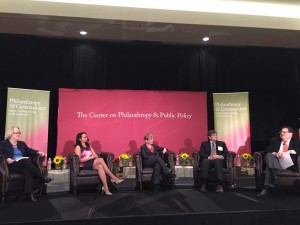Creating Change at the Intersection of Philanthropy and Government
Resource type: News
The Atlantic Philathropies |
 How can we achieve more impact through partnerships between philanthropy and government? What does philanthropy need to do differently to better work with government groups to address the 21st century’s most pressing problems? And how can better communication play a part in achieving these goals?
How can we achieve more impact through partnerships between philanthropy and government? What does philanthropy need to do differently to better work with government groups to address the 21st century’s most pressing problems? And how can better communication play a part in achieving these goals?
Last month, Atlantic Philanthropies President and CEO Christopher Oechsli and Chief Communications Officer David Morse joined leaders from the philanthropy, government, and business worlds at the USC Center on Philanthropy and Public Policy’s 2016 National Leadership Forum to learn from peers and discuss their experiences grappling with these big picture questions for the sector.
Morse moderated a discussion on effective communications as a strategy to push for public policy change, and the ways foundations succeed and fail as communicators, with ColorofChange Executive Director Rashad Robinson, President and CEO of The California Wellness Foundation Judy Belk, and Kristen Grimm, Founder and President of Spitfire Strategies.
One key takeaway was that successful communications means asking if grantees are reaching the right audience—and giving them the freedom to change course if they’re not.
“One of the things that I’ve learned, because it had to be beaten over my head multiple times, is: the general public is not your audience,” said Morse. “If you’re trying to create policy change…you have to target the messengers; you have to target the campaign that you’re engaging in.”
David Morse on “the most overused word in philanthropy”
Knowing which audiences to target and whether to apply positive or negative pressure, explained Grimm, is vital for philanthropy.
“Philanthropy plays a very important role in [supporting] grantees that are going to put up that negative pressure,” said Grimm. For example: Some of the best philanthropic work right now is coming out of Flint,” Grimm said, where grantees are holding government accountable for their actions.
On issues like net neutrality, public pressure from someone like John Oliver, a popular media personality, coupled with deep grassroots engagement driven by groups like ColorofChange can create an ‘activation point’, resulting in strong government action.
Robinson pointed out there’s a difference between having presence and power. “Sometimes we mistake having presence, having visibility on an issue, for actually having power in the room where we need to have power,” he explained.

Communicating effectively was just one piece of the larger conversation on how philanthropy can expand its capacity to solve public problems. At the closing plenary session, Oechsli joined a group of foundation leaders for “What Does Philanthropy Need to Do Differently?”, a discussion of how philanthropy should move forward to address the problems of the 21st century.
The panel—made up of Weingart Foundation President and CEO Fred Ali, The David and Lucile Packard Foundation President and CEO Carol Larson, Ford Foundation Vice President of Education, Creativity, and Free Expression Hilary Pennington, and Dalila Wilson-Scott, President and Head of Global Philanthropy at the JPMorgan Chase Foundation—discussed ways to overcome the challenges of working with government partners, how to make “big bets” that truly have big impact, and creating lasting change through collaboration.
“Being a limited life organization has allowed us to go into what we call big bets. Not necessarily single big bets—although we’ve made some of those—but also clusters around issues where we think we can have some impact in a relatively modest period of time, within our lifetime,” said Oechsli. “Not spending to budget but spending to impact has been very effective.”
Christopher Oechsli discusses Atlantic’s ‘big bets’
“That said, I don’t want to suggest that we’re looking for short term results,” he added. “A lot of what we care about, even with our limited life grantmaking, are very complex issues that extend well beyond the life of the organization. And so we’re very interested in investing in—for example, human capital or in physical capital—things that have a life of 20, 30, or even longer, years.”
Despite the challenges, collaboration between philanthropic groups and government agencies is critical to making long term impact, explained Oechsli. As Atlantic’s work comes to a close, it’s planting its final seeds in the fields of health equity, racial equity, inequality, and democracy in the hopes they will blossom, sustain, and support the people and institutions carrying on this vital work well into the future.
Christopher Oechsli talks about limited life philanthropy and Atlantic’s culminating strategy